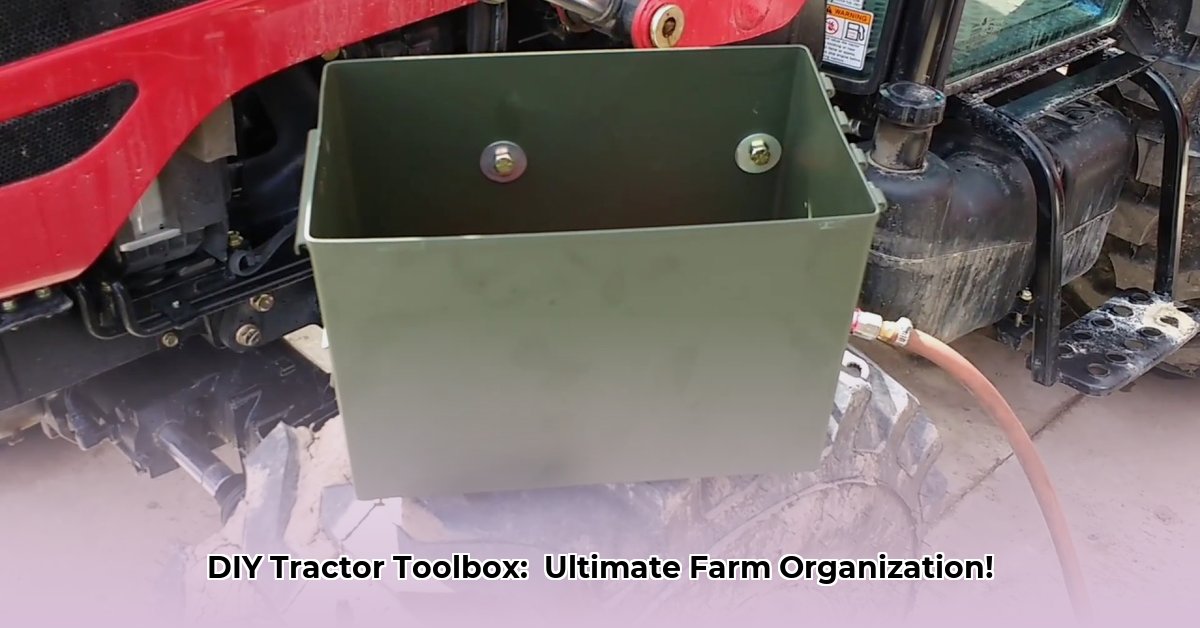
Let's face it: store-bought tractor toolboxes are expensive and often lack durability. But what if you could craft a tougher, more customized, and eco-friendly solution? This guide provides step-by-step instructions and comparative analyses to help you build your own sustainable tractor toolbox. We'll explore various materials and designs, focusing on practical solutions and long-lasting results.
Picking the Perfect Materials: A Comparative Analysis
Material selection is crucial. The wrong material can lead to a short-lived toolbox. Your choice depends on budget and the harshness of your working environment. Here's a comparison of popular options:
| Material | Advantages | Disadvantages | Sustainability Score |
|---|---|---|---|
| Repurposed Metal (e.g., Ammo Cans) | Extremely durable, weather-resistant, readily available (often free) | May require rust removal and repair; potential for uneven surfaces | High |
| New Steel or Aluminum | Incredibly strong, long-lasting | High initial cost; less environmentally friendly than recycled options | Medium |
| Heavy-Duty Plastic | Inexpensive, lightweight, easy to transport | Less durable than metal; can crack or fade in sunlight | Low |
| Recycled Plastic | Budget-friendly, environmentally conscious | Durability varies greatly depending on quality and type of plastic | Medium to High |
Consider your climate and usage. Metal excels in harsh weather, while plastic is suitable for milder conditions. Cost is also a factor; metal has a higher upfront cost.
Designing Your Dream Toolbox: Planning for Success
Before you start building, plan your design carefully. Consider these key elements:
- Size and Shape: Determine the necessary capacity and consider maneuverability. A larger toolbox offers more storage but can be cumbersome.
- Mounting: Secure mounting is paramount for safety. Use strong brackets and fasteners (U-bolts are popular).
- Accessibility: Design for easy access to tools. Drawers, shelves, and compartments enhance organization.
- Weatherproofing: A tight-fitting lid is essential, especially for metal boxes, to prevent rust. Consider weather sealing for added protection. A waterproof sealant is recommended.
Building Your Toolbox: A Step-by-Step Guide (Using Repurposed Ammo Cans)
This guide uses repurposed ammo cans, a readily available and sustainable material. Adapt these steps for other materials.
Preparation: Thoroughly clean the ammo cans, removing rust and debris. Apply a primer coat before painting.
Mounting Brackets: Fabricate or purchase sturdy mounting brackets. Ensure a secure fit to your tractor. Pre-drilling holes is recommended to prevent cracking.
Assembly: Securely attach the ammo cans. Welding is recommended for a robust structure. Ensure watertight seals between cans, if stacking.
Painting and Protection: Apply two coats of high-quality, weather-resistant paint for corrosion protection. Consider additional sealant for extra protection.
Mounting and Testing: Carefully mount the toolbox onto your tractor, ensuring secure attachment. Test its stability before full usage.
Going Beyond the Basics: Enhancing Your Toolbox
To further enhance your toolbox consider these upgrades:
- Dividers and Organizers: Improve tool organization and accessibility.
- Locking Mechanism: Protect your tools from theft with a secure lock.
- Integrated Lighting: Facilitate tool retrieval in low-light conditions.
Remember, the ideal toolbox is tailored to your specific needs. Prioritize practicality and durability. Enjoy the process and the satisfaction of creating a robust, sustainable, and customized solution!
How to Build a Sustainable and Durable DIY Tractor Toolbox Using Recycled Materials
Key Advantages:
- Cost savings compared to store-bought alternatives.
- Reduced environmental impact through material reuse.
- Customization to perfectly fit your needs and tools.
- Enhanced durability through careful planning and construction.
Choosing Your Materials: Prioritizing Sustainability
Prioritize readily available recycled materials. Consider old steel drums, discarded sheet metal, or even salvaged (properly treated) lumber. Resourcefulness is key to a truly sustainable project.
Here's a summarized material comparison:
| Material | Pros | Cons | Sustainability Considerations |
|---|---|---|---|
| Recycled Steel | Strong, durable, weather-resistant | Requires welding/metalworking skills | Excellent; minimizes waste |
| Reclaimed Lumber | Relatively easy to work with; often inexpensive | Susceptible to rot and pests; requires proper treatment | Moderate; depends on lumber source and treatment methods |
| Repurposed Plastic | Easily available; often free | Less durable than metal; susceptible to UV damage | Poor; often non-recyclable; carefully consider alternatives |
Careful material selection is key for a sustainable and durable outcome.
Design Considerations: Functionality First
Consider your needs and tractor's characteristics when designing. Sketch your design first!
- Secure Mounting: Robust mounting is crucial.
- Accessibility: Tools must be readily accessible.
- Weather Protection: Protect your tools from the elements.
Step-by-Step Construction: A Recycled Steel Toolbox Example
This section details building a toolbox from recycled steel; adapt as needed for other materials.
Material Acquisition: Source recycled steel responsibly and safely.
Cutting and Shaping: Cut the steel to your design's precise dimensions using appropriate tools and safety gear.
Assembly: Weld the pieces together, ensuring strong and even welds.
Feature Addition: Install hinges, latches, and handles. Apply a weather-resistant paint finish.
Mounting: Design and build a strong mounting bracket for your tractor.
Finishing: Apply a protective coating and sand down any sharp edges.
Maintaining Your DIY Toolbox
Regular inspection and prompt maintenance are key for longevity. Address any problems promptly. A little preventative maintenance will extend its lifespan.